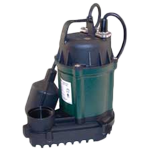Sump Pumps

At Horizon Enterprises Plumbing & Heating, Inc., we offer a variety of solutions that can handle any of your wastewater issues. From standard sump pumps to innovative water powered pumps, we can recommend the products that will protect your property from damage. Our commitment to using the best technology and extensive industry experience makes us the best option to handle all of your home or commercial wastewater needs.
We offer solutions with the following products:
Sump Pumps
A sump pump is the first line of defense if your basement floods, so it is important that you choose the right solution for your home.
What is a Sump Pump?
A sump pump is a small pump found at the lowest part of a crawlspace or basement. It works to keep the area under a building dry and to prevent flooding. These pumps are usually installed in sump pits, and their job is to pump water out of the pit and away from the structure.
How it Works
As the sump pit in your crawlspace or basement fills with water, a sump pump should automatically turn on when a float activator arm is triggered. The float activator will work similar to a toilet tank – a buoyant ball will float on the top of the water before tripping the pump switch once the water reaches a specific level.
The sump pump then works to move liquid out of the pit and through a series of pipes that lead away from your home. The water will drain to a safe place away from your property’s foundation, and because the pipe includes a one-way check valve, it should not flow back into the pit.
Battery Backup Sump Pumps
Unfortunately, electricity isn’t always reliable, so it is important to have a backup solution in place in the event that your property experiences a wastewater event. A battery backup sump pump isn’t connected to your home’s electrical system, and it runs off of a battery. It is usually found in the same place as the main pump, although it should be slightly elevated.
Why Do You Need a Battery Backup Sump Pump?
After you invest in a sump pump, you may be wondering why you would need an additional backup pump. Unfortunately, like all systems, primary sump pumps have a limited lifespan. They could fail for several reasons, and a backup system will be there in case of an emergency:
- Power outage. Should your electricity go out, your battery backup pump will activate.
- Float switch malfunctions. Should your float switch malfunction, rising water levels can automatically activate your backup system.
- Primary pump failure. Should your primary pump fail completely, the backup sump pump will automatically take over.
- Failure to keep up with water inflow. If the primary pump simply can’t keep up with the inflow of water, backup system activation can help lessen the load.
Don’t wait until a wastewater emergency to find out your primary pump isn’t working or can’t handle the job. Invest in a battery backup system today.
Water Powered Pumps
If you are in need of a backup option to your primary electric sump pump, a water powered pump is a great solution.
What is a Water Powered Pump?
A water powered pump provides you with an efficient way to pump out water without a battery backup or the use of electricity. As long as you have access to city water, you’ll have a working pump and dry basement – even in the event of a power failure. Unfortunately, this won’t be an option for homes that use well water.
How it Works
Water powered sump pumps work because of the Venturi effect. When connected to city public works, water will flow through the pump. The constriction that results will cause a reduction in pressure that literally sucks water out of the sump pit. The water will then combine with your home’s flowing city water before exiting the basement via a discharge line.
Sewage Ejector Systems
Also known as a sewage ejector pump, these systems closely resemble sump pumps, but they have been designed for specific use in sewage applications.
What is a Sewage Ejector System?
Sewage ejector systems are used when a laundry room, bathroom, or other plumbing fixture is installed below the main septic or sewer line grade. They are typically installed in basements and are part of a larger system designed to pump both liquids and solids.
There is a key distinction between sewage ejection systems and waste water sump pumps – a vent. With a sewage ejector pump, a vent needs to be installed to run from the sump pump through the room. The top of the sump pit will be sealed so that no waste or odors can seep out of the basin.
How it Works
Sewage ejector systems are intended to sit in their own sump pit and should be kept away from your normal waste water sump pit. Similar to a sump pump, when waste water levels in the pit reach a certain height, a float is tripped. The waste water is then pumped up and out of the basin and to ground level. From there it is pumped to the sewer or septic tank.
If you are in need of a sump pump for your home or business, it is important to make the right selection. Let us help you to explore your options and create the best possible solution.



